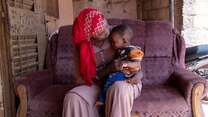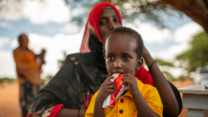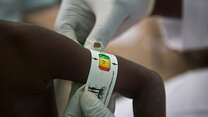Who we are
The mission of the International Rescue Committee (IRC) is to help people whose lives and livelihoods are shattered by conflict and di- saster to survive, recover and gain control of their future. Our vision is that the IRC will lead the humanitarian field by implementing high-im- pact, cost-effective programs for people affected by crisis, and we will shape global policy and practice by sharing our learning and experience with others.
All IRC programs are designed to achieve meaningful change in people’s health, safety, education, economic wellbeing and ability to influence the decisions that affect their lives. As part of these efforts, we work to implement proven interventions that facilitate the greatest potential for healthy women and children.
Our nutrition vision
IRC Nutrition programs will accelerate action against malnutrition and protect the nutritional status of women and children in crisis by:
- Investing in cutting-edge research to transform the way malnutrition treatment is delivered to reach more children, cut-out inefficiencies, reduce relapse, sustain recovery and simplify treatment protocols.
- Advocacy and affecting policy changes to replicate new approaches to prevent and treat malnutrition
- Delivering an evidence based nutrition package to protect the nutritional status of women and children in crisis-affected contexts. Where evidence is insufficient, we will design and test new approaches to benefit IRC’s clients.
We will measure our effectiveness and report on our reach and quality of services.
Why our work matters
Poor nutrition is often life-threatening but almost always avoidable. Treating malnutrition and protecting nutritional status for women and children are some of the most effective ways to improve growth and development in children. But for millions in crisis-affected areas, access to critical services and resources remain out of reach—changing the course of a lifetime.
- Acute malnutrition in children. 51 million children are suffering from acute malnutrition, which is linked to nearly half of all deaths of children under the age of five. The vast majority of these children do not have access to treatment.
- Micronutrient deficiencies. In crisis settings, mothers and children lack access to nutrient-dense foods. For children, this can lead to night blindness, poor immunity to severe infections, and a restricted ability to grow and learn.
- Suboptimal infant and young child nutrition. Optimal breastfeeding and complementary feeding can prevent nearly 20 percent of all child deaths. In crisis settings, supporting infant feeding (breastfed and non-breastfed infants) is even more critical since children have limited access to food, water and protection from illness. Though infant and young child nutrition is the most effective public health intervention to decrease child mortality, it receives the least donor attention.
What we do
IRC practitioners provide technical assistance to more than 30 country programs. Technical advisors are charged with staying abreast of the best available research and practices in their respective fields and support IRC’s frontline teams to implement best practice. They also lead research and advocacy strategies to encourage uptake of interventions proven to be effective.
Strategies to transform the treatment of acute malnutrition
Improving access and bringing treatment closer to home:
Child mortality is unacceptably high in many countries because health systems are weak and services are far away. Through integrated community case management (iCCM) of childhood illnesses, the assessment and treatment of diarrhea, malaria and pneumonia have been simplified, allowing community health workers (CHW) with little or no education to provide quality care. As a result, treatment for these leading killers of children is now available in some of the most hard-to-reach places.
We believe more must be done to increase access and coverage of acute malnutrition treatment. Using this simple but revolutionary lesson, we developed a simplified protocol and tools adapted for low-literate CHWs to treat acute malnutrition in their communities. Using these tools, CHWs in South Sudan were able to adhere to the treatment protocol and provide quality treatment that met performance targets. IRC is currently leading a consortium of four other NGOs (Action Against Hunger, Concern Worldwide, Malaria Consortium, Save the Children) and have pilots ongoing to replicate this approach in other contexts to inform the evidence base.
Read more about the IRC’s research in South Sudan to treat children with acute malnutrition: Enabling treatment of Severe Acute Malnutrition in the community
Improving continuity of treatment between moderate and severe malnutrition:
The global approach to treating malnourished children requires a new way forward. Although acute malnutrition is a condition that changes along a continuum, children with severe and moderate acute malnutrition are treated separately with different protocols and therapeutic products managed by separate UN agencies. Often only treatment for severe acute malnutrition (SAM) is available leading to a higher risk of relapse. Moderate acute malnutrition (MAM) should be a non-negotiable part of any treatment program intent on reducing the burden of malnutrition. IRC believe that all malnourished children should be treated through full recovery in one program.
To address these gaps, the IRC is conducting research to test the effectiveness of a combined protocol for acute malnutrition so that all children— regardless of where they fall on the spectrum of malnutrition—are treated in one program through full recovery. We believe this will improve cost-effectiveness, reduce relapse and improve coverage of MAM treatment.
Read more about the IRC’s research assess a combined protocol treating all children with acute malnutrition in one place, with one product: Combined Protocol for SAM/MAM Treatment: the ComPAS study
The IRC is assessing potential policy barriers to uptake of the combined protocol in Somalia: Tackling the burden of Acute Malnutrition
Effecting policy change to improve treatment of acute malnutrition:
The IRC is launching an ambitious policy change agenda to ensure that all children with acute malnutrition- those with severe and moderate malnutrition- can access treatment. The IRC is leveraging its voice, influence, and research expertise to ensure key global actors enact policy change to adopt new, effective approaches to improve treatment outcomes for malnourished children. As a member of the No Wasted Lives Coalition, the IRC is also closely coordinating with a wider community of peer implementing organizations and donors, leveraging expertise across organizations for common research and advocacy goals.
Helping caregivers meet their infant and young child feeding goals:
The IRC believes that treatment for malnutrition by itself is not enough and more must be done to sustain recovery and to prevent malnutrition from occurring in the first place. Infant and young child nutrition is one of the most effective ways to reduce the death of children, yet little progress is being made. Only 41 percent of children under six months of age are exclusively breastfed and more households are affected by food insecurity than ever before.
The IRC believes it’s time for a rethink to current approaches that deliver generic nutrition education messages usually targeted at women, which fail to address common challenges. We feel more must be done to support both breastfed and non-breastfed infants. We are working to design and test client-driven approaches to empower women to meet their goals. We work to increase individual choice through income that can incorporate cultural preferences and improve nutrition for young children. Finally, we believe that infant and young child nutrition interventions must integrate early learning, stimulation and play for children under 3 to support children’s cognitive development and growth.
Applying evidence and measuring our effectiveness:
The IRC believes it’s important to deliver evidence-based services and has created evidence-based theories of change, training packages and toolkits for all of our global nutrition programs. We are dedicated to measuring our effectiveness and adapt our programming to better deliver services. IRC has created a measurement package for the management of acute malnutrition to provide a deep analysis of routine data. We are rolling that out to our nutrition programs and are working on the creation of a standard measurement package for infant and young child nutrition programs in 2018.
AVAILABLE DOCUMENTS & LINKS
- Download this resource
Nutrition at the International Rescue Committee
- The International Rescue Committee is a leading humanitarian agency dedicated to the health and survival of the most vulnerable people around the world. From the earliest stages of emergencies through recovery, we provide essential services.
Health at the International Rescue Committee
- In acute emergencies, the IRC establishes emergency water, sanitation and hygiene promotion programs, ensuring that life-saving services can be initiated efficiently.
Environmental Health at the International Rescue Committee
- For more than 20 years, the IRC has been breaking down barriers that prevent gender-based violence survivors from disclosing violence and seeking services.
Clinical care for survivors of gender-based violence at the International Rescue Committee
- The IRC is committed to bringing life-saving immunization to children in the most challenging and hard-to reach areas. We work in 18 fragile, crisis-affected countries to ensure that caregivers and infants can access immunizations.
Immunization at the International Rescue Committee
- the IRC is dedicated to helping people affected by conflict access mental health and psychosocial support. We work to ensure that people can receive care and manage treatment for themselves and their families.
Mental health at the International Rescue Committee
- The IRC supports simple, cost-effective and proven interventions that result in fewer unplanned pregnancies, safer pregnancy and childbirth, and reduced physical and emotional harm from gender-based violence.
Reproductive health at the International Rescue Committee



